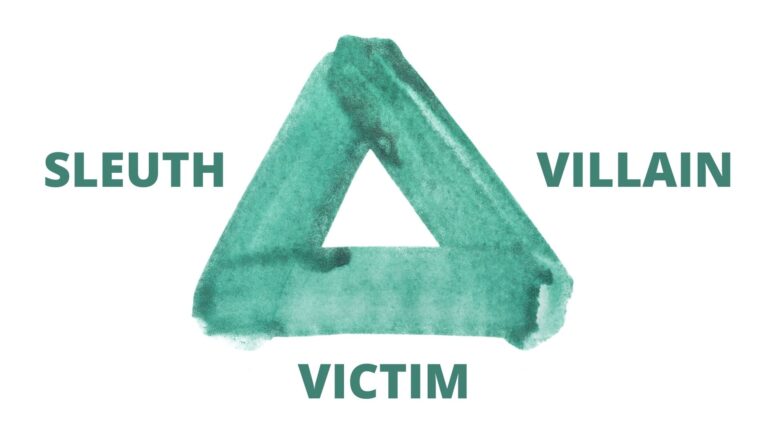How to Keep Your Mystery Villain a Secret To Surprise Your Reader at The End

Keep Your Villain Hidden Until The End
One of the biggest challenges for beginning mystery writers is how to present the villain and still keep that character hidden until the sleuth reveals them at the end. You want to share enough of the villain so your reader feels they could have guessed. On the other hand, you don’t want to give away to much in the story so your reader guesses the villain before the end.
To keep your villain hidden as the perpetrator until the end you need to create a discipline in your story. The bits you share about your villain are like any other clues.
First, Focus on the Villain
To maintain control over where and how you add information about your villain, first, you need to know your villain well. A rich character background allows you to pull various pieces of information out and plant them in your story.
Think of your background as data collection. Then drip various pieces of information throughout the story. Use those bits of data the same way you add other clues to your mystery.
Throughout most of your mystery, the villain is one of several suspects. Create a rich background. You’ll give yourself a variety of puzzle pieces to drop into your story. Go beyond the villain as a character role. Give her a name, a background with relationships, physical fallibility, and emotional weakness.
- Personal life not related to the victim
- Secrets they want to keep hidden
- Lies they tell to preserve the secrets
- Life related to the victim
In your background, focus on the relationship between the villain and the victim. Their relationship is the basis for the murder and the sleuth’s involvement. Think of ways the two connected, then the ways things went wrong, and finally the one incident that tipped the villain to murder.
The Slow Drip of Villain Clues
Armed with your deep character development, you are ready to drip clues about your villain into your mystery without giving away the end.
Here are some tried-and-true ways to deliver those close without revealing the end.
Sequence Diversion –
Put the real clue right before the false one. Readers and your sleuth often focus on the last clue presented. If you are getting started with mystery writing, this tactic is a great place to start. Mention or show the clue first and then immediately focus on a different clue or red herring.
Secret Emphasis –
Emphasize the unimportant, but de-emphasize the clue. The reader sees the clue but doesn’t see what’s important about it. For example, your sleuth may see the value of a company report and the statistical details but doesn’t look at the man who researched and wrote the report.
Before It Counts –
Early on plant the clue before it has any context. Your sleuth may walk by a man cleaning his yacht with chemicals before a business partner dies of toxic chemical poisoning. Carolyn Graham uses this tactic in her Inspector Barnaby mysteries.
Missed It –
Your sleuth misinterprets the meaning of a clue. You villain lies to hide a secret. Your detective believes what the villain says, at the moment. But what the villain says points to his act, even though he lies. This is a great tool to use with a flawed sleuth whose flaw keeps her from seeing the real meaning.
Piece by Piece –
A time-release method to scatter clues about the villain in different places through the story. Then mix up the logical order. Your sleuth finds an empty letterbox while visiting the villain. Later on she finds six letters hidden in the closet. She has an “epiphany” when she remembers the empty aquarium.
In Plain Sight –
Create a cluster of clues and squeeze the real clue in with all the others. Hide the clue in plain sight. While your sleuth interviews the villain as a suspect, they rattle on with false clues but one real clue is hidden in the cluster. This technique works well in a story with multiple suspects from Agatha Christie’s Murder On The Orient Express to John D. MacDonald’s hard-boiled Travis McGee (pick one).
Distraction –
Draw your reader’s attention away from the villain. The sleuth and the reader follow a false trail. A suspect who seems like the most evident villain is not the real trail to the villain. In Adrian McKinty’s The Cold, Cold Ground the clues seem to lead toward a serial killer who targets homosexuals. Not the case at all.
Camouflage with Action –
Camouflage a clue with action. Just as your sleuth glances at a scrap of paper on the floor, he’s hit from behind. In the ensuing action and consequences—trip to the hospital, a missed appointment because of time in the hospital, etc.—your sleuth overlooks the clue that points straight to the villain. Jo Nesbø uses action camouflage in his Harry Høle series.
The Challenge of Knowing Too Much
Beginning writers and experienced mystery writers know so much about the villain they find it hard to get perspective. Because you know so much about the villain, a clue you plant may seem obvious to you.
Practice using the techniques, to reveal your villain without giving away the secret. Let your sleuth use their skills to put it all together.
Photo by Philipp Lansing on Unsplash





